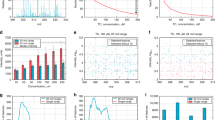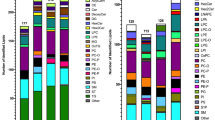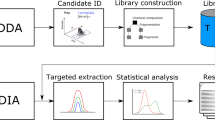Abstract
Analytical techniques with high sensitivity and selectivity are essential to the quantitative analysis of clinical samples. Liquid chromatography coupled to tandem mass spectrometry is the gold standard in clinical chemistry. However, tandem mass spectrometers come at high capital expenditure and maintenance costs. We recently showed that it is possible to generate very similar results using a much simpler single mass spectrometry detector by performing enhanced in-source fragmentation/annotation (EISA) combined with correlated ion monitoring. Here we provide a step-by-step protocol for optimizing the analytical conditions for EISA, so anyone properly trained in liquid chromatography–mass spectrometry can follow and apply this technique for any given analyte. We exemplify the approach by using 2-hydroxyglutarate (2-HG) which is a clinically relevant metabolite whose d-enantiomer is considered an ‘oncometabolite’, characteristic of cancers associated with mutated isocitrate dehydrogenases 1 or 2 (IDH1/2). We include procedures for determining quantitative robustness, and show results of these relating to the analysis of dl-2-hydroxyglutarate in cells, as well as in serum samples from patients with acute myeloid leukemia that contain the IDH1/2 mutation. This EISA–mass spectrometry protocol is a broadly applicable and low-cost approach for the quantification of small molecules that has been developed to work well for both single-quadrupole and time-of-flight mass analyzers.
This is a preview of subscription content, access via your institution
Access options
Access Nature and 54 other Nature Portfolio journals
Get Nature+, our best-value online-access subscription
$29.99 / 30 days
cancel any time
Subscribe to this journal
Receive 12 print issues and online access
$259.00 per year
only $21.58 per issue
Buy this article
- Purchase on Springer Link
- Instant access to full article PDF
Prices may be subject to local taxes which are calculated during checkout







Similar content being viewed by others
Data availability
The CIM algorithm is available at https://github.com/ricoderks/eisaCIM. Supporting data have been included in the primary research papers as well as this protocol. Further validation data are available from the authors upon request.
References
Holcapek, M., Jirasko, R. & Lisa, M. Recent developments in liquid chromatography–mass spectrometry and related techniques. J. Chromatogr. A. 1259, 3–15 (2012).
Leung, K. S.-Y. & Fong, B. M.-W. LC–MS/MS in the routine clinical laboratory: has its time come? Anal. Bioanal. Chem. 406, 2289–2301 (2014).
Wishart, D. Emerging applications of metabolomics in drug discovery and precision medicine. Nat. Rev. Drug. Discov. 15, 473–484 (2016).
Blaženović, I., Kind, T., Ji, J. & Fiehn, O. Software tools and approaches for compound identification of LC–MS/MS data in metabolomics. Metabolites 8, 31 (2018).
Xue, J. et al. Enhanced in-source fragmentation annotation enables novel data independent acquisition and autonomous METLIN molecular identification. Anal. Chem. 92, 6051–6059 (2020).
Xue, J. et al. Single quadrupole multiple fragment ion monitoring quantitative mass spectrometry. Anal. Chem. 93, 10879–10889 (2021).
Xue, J., Derks, R. J. E., Hoang, L., Giera, M. & Siuzdak, G. Proteomics with enhanced in-source fragmentation/annotation: applying XCMS–EISA Informatics and Q-MRM high-sensitivity quantification. J. Am. Soc. Mass Spectrom. 32, 2644–2654 (2021).
Dang, L. et al. Cancer-associated IDH1 mutations produce 2-hydroxyglutarate. Nature 462, 739–743 (2009).
Struys, E. A., Jansen, E. E. W., Verhoeven, N. M. & Jakobs, C. Measurement of urinary d- and l-2-hydroxyglutarate enantiomers by stable-isotope-dilution liquid chromatography-tandem mass spectrometry after derivatization with diacetyl-l-tartaric anhydride. Clin. Chem. 50, 1391–1395 (2004).
Zhou, J. & Yin, Y. Strategies for large-scale targeted metabolomics quantification by liquid chromatography–mass spectrometry. Analyst 141, 6362 (2016).
González-Ruiz, V., Olives, A. I. & Martin, M. A. Core-shell particles lead the way to renewing high-performance liquid chromatography. TrAC-Trend Anal. Chem. 64, 17–28 (2015).
Ciccimaro, E. & Blair, I. A. Stable-isotope dilution LC–MS for quantitative biomarker analysis. Bioanalysis 2, 311–341 (2010).
González, A. G., Herrador, M. A. & Asuero, A. G. Intra-laboratory assessment of method accuracy (trueness and precision) by using validation standards. Talanta 82, 1995–1998 (2010).
Pansuriya, T. C. et al. Somatic mosaic IDH1 and IDH2 mutations are associated with enchondroma and spindle cell hemangioma in Ollier disease and Maffucci syndrome. Nat. Genet. 43, 1256–1261 (2011).
Gil-Benso, R. et al. Establishment and characterization of a continuous human chondrosarcoma cell line, ch-2879: comparative histologic and genetic studies with its tumor of origin. Lab. Invest. 83, 877–887 (2003).
Scully, S. P. et al. Marshall Urist Award. Interstitial collagenase gene expression correlates with in vitro invasion in human chondrosarcoma. Clin. Orthop. Relat. Res. 376, 291–303 (2000).
Arindrarto, W. et al. Comprehensive diagnostics of acute myeloid leukemia by whole transcriptome RNA sequencing. Leukemia 35, 47–61 (2021).
Oldham, W. M. & Loscalzo, J. Quantification of 2-hydroxyglutarate enantiomers by liquid chromatography-mass spectrometry. Bio. Protoc. 20, e1908 (2016).
Gu, H., Liu, G., Wang, J., Aubry, A.-F. & Arnold, M. E. Selecting the correct weighting factors for linear and quadratic calibration curves with least-squares regression algorithm in bioanalytical LC–MS/MS assays and impacts of using incorrect weighting factors on curve stability, data quality, and assay performance. Anal. Chem. 86, 8959–8966 (2014).
Analytical Procedures and Methods Validation (US Food and Drug Administration, 2000).
Kranendijk, M., Struys, E. A., Salomons, G. S., Van der Knaap, M. S. & Jakobs, C. Progress in understanding 2-hydroxyglutaric acidurias. J. Inherit. Metab. Dis. 35, 571–587 (2012).
Acknowledgements
This work was supported by the Program for Guangdong Introducing Innovative and Entrepreneurial Teams (2019ZT08L213), the Guangdong Provincial Key Laboratory Project (2019B121203011), Key-Area Research and Development Program of Guangdong Province (2020B1111380003), the Leiden Center for Computational Oncology (LCCO), the Spanish Ministry of Science and Innovation (PID2019-104913GB-I00 project) and the Spanish Ministry of Economy and Competitiveness (S.B.-B.’s predoctoral research contract (BES-2017-082458)). This research was partially funded by the National Institutes of Health grants R35 GM130385 (G.S.) and U01 CA235493 (G.S.). The authors are grateful to A. Llombart-Bosch (University of Valencia, Spain) for the CH2879 cell line and J.A. Block (Rush University Medical Centre, Chicago, IL, USA) for the JJ012 cell line. Authors would also like to thank Ieva Palubeckaitė and Judith Bovée (Department of Pathology, Leiden University Medical Center, the Netherlands) for providing chondrosarcoma cells and valuable discussion, Hans Dalebout and René van Zeijl (Center for Proteomics and Metabolomics, Leiden University Medical Center, the Netherlands) for their technical assistance and Peter van Balen (Department of Hematology, Leiden University Medical Center, the Netherlands) for providing the serum samples.
Author information
Authors and Affiliations
Contributions
Conceptualization: S.B.-B., J.X., G.S., M.Giera, E.S.-L. Methodology: S.B.-B., J.X., L.H., E.B., B.W., B.H., G.S., M.Giera, E.S.-L. Acquisition of biological material: M.W.H., S.V., E.B.A., M.Griffioen. Investigation: S.B.-B., J.X., G.S., M.Giera, E.S.-L. Funding acquisition: J.X., B.H., M.C.-P., M.L.M., E.B.A., G.S., M.Giera. Supervision: G.S., M.Giera, E.S.-L. Writing of the original draft: S.B.-B., J.X., G.S., M.Giera, E.S.-L. All authors reviewed and edited the manuscript. S.B.-B. and J.X. contributed equally as co-first authors.
Corresponding authors
Ethics declarations
Competing interests
The authors declare no competing interests.
Peer review
Peer review information
Nature Protocols thanks Stephan Hann and the other, anonymous, reviewer(s) for their contribution to the peer review of this work.
Additional information
Publisher’s note Springer Nature remains neutral with regard to jurisdictional claims in published maps and institutional affiliations.
Related Links
Key references using this protocol
Xue, J. et al. Anal. Chem. 92, 6051–6059 (2020): https://doi.org/10.1021/acs.analchem.0c00409
Xue, J. et al. Anal. Chem. 93, 10879–10889 (2021): https://doi.org/10.1021/acs.analchem.1c01246
Supplementary information
Supplementary Information
Supplementary Procedure and Figs. 1–5.
Rights and permissions
Springer Nature or its licensor (e.g. a society or other partner) holds exclusive rights to this article under a publishing agreement with the author(s) or other rightsholder(s); author self-archiving of the accepted manuscript version of this article is solely governed by the terms of such publishing agreement and applicable law.
About this article
Cite this article
Bernardo-Bermejo, S., Xue, J., Hoang, L. et al. Quantitative multiple fragment monitoring with enhanced in-source fragmentation/annotation mass spectrometry. Nat Protoc 18, 1296–1315 (2023). https://doi.org/10.1038/s41596-023-00803-0
Received:
Accepted:
Published:
Issue Date:
DOI: https://doi.org/10.1038/s41596-023-00803-0
Comments
By submitting a comment you agree to abide by our Terms and Community Guidelines. If you find something abusive or that does not comply with our terms or guidelines please flag it as inappropriate.



